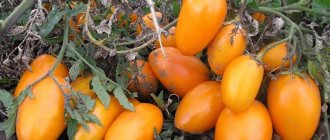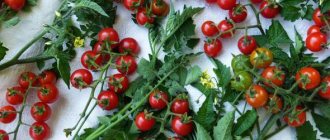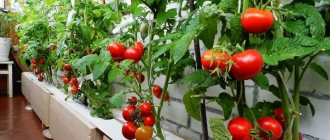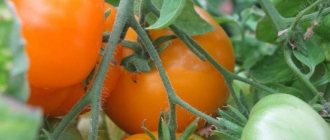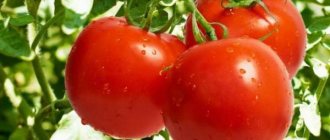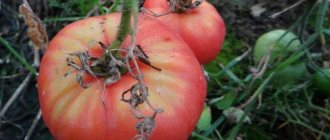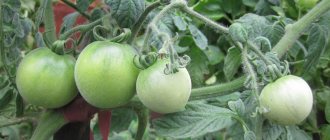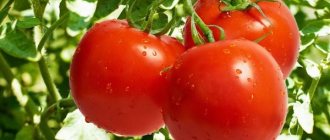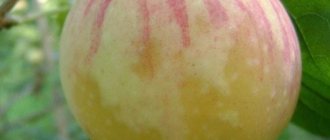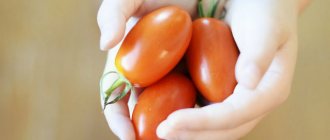The main features of the climate of the Moscow region
The climate of the Moscow region (Moscow region) is characterized by moderate continentality. There is a pronounced seasonality here, warm in summer and cold in winter. The beginning of the spring-summer period occurs at the end of March - in early April. The winter season begins at the end of November.
Temperatures in the warm season range from +16℃ in May to +18℃ in July, precipitation is 250-270 mm. In winter, the average air temperature in the west of the country reaches -8℃, in the east -1℃, but frosts down to -20℃ occur. The height of the snow cover is 20-60 cm. The average annual humidity is high, reaching 77%. In summer there are more cloudy days.
The duration of daylight hours in summer is 15-17 hours, in winter – 7-10. Wind speed in the cold season is 4.7 m/s, in the warm season – 3.5 m/s. The greatest movement of air masses is observed in the morning hours.
The most productive
Below are high-yielding tomato varieties that will give the desired yield with proper care throughout the growing season.
Pink raisins
The tomato was bred by Ukrainian selection. The variety amazes with the abundance of delicious, beautiful fruits; about 50 pieces can grow on a fruit branch. Determinate bush up to 1.5 m in height, has high resistance to common diseases. An early ripening variety, the fruits are harvested on the 90th day.
Wonder of the earth
Tall indeterminate bush up to 2 m high. Formed by one or two trunks, requires staking. It has large pink fruits, about 300 g each, so it is not suitable for preservation. The brush can contain up to 15 pieces. Early ripening variety.
Mikado pink
It is not a hybrid, an indeterminate variety, the height of the bush reaches 2.5 meters. Refers to early-ripening tomatoes; the harvest is harvested after 90 days, up to 9 kg per bush. Formed into one trunk. The pulp and skin are dense, which allows them to be transported.
The best varieties of tomatoes for greenhouses: description, photo
There are many varieties of tomatoes bred specifically for growing in greenhouse conditions. All of them differ in their taste, have increased resistance to diseases and pests, and are suitable for fresh consumption and canning.
The best tomato varieties for 2021 for greenhouses in the Moscow region:
- Sweet bunch is an early variety, the fruits are round, red, sweetish in taste, ripen in 105 days after sowing vegetable seeds for seedlings. The average yield is from 8 to 10 kg per 1 m².
- Cardinal is a mid-early variety, ripens in 115-120 days, the bushes are tall, the fruits are heart-shaped, large, juicy, the weight of one tomato can reach 450 g. From 1 m² of greenhouse you can harvest up to 14 kg of vegetables.
- Alsou - the harvest begins to ripen early, the fruits are large, bright pink, fleshy, juicy, the average weight reaches 500 g. The tomatoes are stale and tolerate transportation well.
- Pink honey is a mid-season, medium-sized variety; the harvest begins to ripen after 155-125 days. The fruits are large, pink, can grow up to 1 kg, and the tomatoes taste sweet. Productivity – 4-6 kg per 1 m² of beds.
- Karotinka is a mid-season variety, the bushes are low-growing. The fruits are elongated, yellow-orange, sweet in taste, the weight of one tomato is 70 g. It is possible to collect up to 6 kg of mature harvest from 1 m².
- Pink flamingo - characterized by medium maturity of the crop and tall bushes. The weight of one fruit is 200-250 g, the tomatoes are sweet, you can get up to 10 kg from 1 m² of territory.
- Yarik - early ripening fruits, medium-sized bushes, large tomatoes 400-500 g each, red after ripening, sweet in taste, suitable for making salads, but not suitable for canning. The variety is characterized by increased resistance to late blight.
The best varieties of tomatoes for the Moscow region in greenhouses (video)
When the tomato seedlings form two strong leaves, they can be transferred from the box to the greenhouse soil. Or make a pick in a different way. It must be remembered that tomatoes love light and without it it will be very difficult for them to grow, much less produce a bountiful harvest. Using the best greenhouse varieties of tomatoes for the Moscow region, as well as following the correct planting technology, you can grow tasty and juicy fruits that will decorate any table or dish with their presence. The main thing is to make the right choice based on the purpose for which vegetables are grown.
- Author: admin
Rate this article:
- 5
- 4
- 3
- 2
- 1
(2 votes, average: 5 out of 5)
Share with your friends!
The most popular tomato hybrids: description, photo
Many vegetable growers prefer to grow hybrid tomatoes rather than varietal tomatoes in a greenhouse. The distinctive features of the latter are:
- high resistance to diseases and pests;
- good immunity;
- excellent taste.
Specifics of growing tomatoes in a greenhouse
Tomatoes are undoubtedly heat-loving vegetables. If you want to get a decent harvest in the Moscow region, it is preferable to grow this plant in closed beds (in greenhouses and greenhouses).
For a greenhouse, you need to allocate a well-lit place in the garden or yard. Sunlight is essential for tomatoes from morning to evening. Experienced gardeners insist that you cannot plant the same vegetable in a greenhouse for several seasons in a row. Ideally, they should be alternated with other crops.
To avoid infecting plants with diseases, before planting tomato seedlings, the greenhouse must be sprayed with a solution of copper sulfate. To prepare the solution, you will need copper sulfate (a tablespoon) and a full bucket of water. Also, it will be necessary to replace the entire top layer of soil.
Ten days before planting tomatoes, you need to thoroughly prepare the beds. The width of each bed should be 50 - 70 cm, height - 20-30 cm. It is necessary to loosen the soil well and ensure drainage. Paths must be made between fresh beds; their width should be 50 cm.
Prepared soil requires the application of mineral and organic fertilizers. For these purposes, double superphosphate, potassium magnesium, wood ash, and sodium nitrate are successfully used.
For greenhouse beds, you need to choose plants that are resistant to diseases of the nightshade family. It is better to choose seeds from plants with limited growth (semi-determinate or determinate). The duration of time from seed germination to harvest should be no longer than four months.
It is necessary to plant ready-grown seedlings when the ground has warmed up sufficiently. In the Moscow region this happens in the first half of May. The soil temperature should not fall below 13°C at a depth of 20 centimeters. In this case, the height of the seedlings themselves should be more than 30 centimeters. These are optimal conditions for transplanting mature seedlings into greenhouse beds.
The distance that must be maintained between individual plants:
- for tall tomatoes – 65 centimeters;
- for medium-sized and short people – 40 centimeters.
Each seedling bush is planted in a hole. Water with manganese solution. To prepare it, you need 1 g of manganese and 10 liters of water. Organomineral fertilizer is also added to the hole.
After the tomatoes are planted, it is advised not to water them again for two weeks. In the future, watering is carried out only at the root of the plant. It is very important that water does not get on the leaves or branches of tomatoes (this will help avoid infection with infectious diseases).
To obtain abundant harvests, tomatoes need to be planted. It is necessary to remove the stepson from the plant until it is no more than 5 centimeters. When the first fruits appear, all leaves that grow below the inflorescence must be removed.
Good results are shown by weekly foliar feeding. This procedure saturates the tomato with all the necessary substances and increases its resistance to all diseases.
Ready tomatoes should be picked a little unripe.
Large-fruited
The dream of every gardener is tomatoes weighing about a kilogram. As a rule, such varieties of tomatoes for a polycarbonate greenhouse have an unsurpassed taste and are quite unpretentious in care.
King of the Giants
The bush has a height of up to 180 cm, is standard, it needs to be tied up. Tomatoes ripen 115-125 days after planting. It is resistant to certain diseases, including late blight. The weight of a tomato reaches 800 g, but the average is 500-600 g. The fruits are red, oval, slightly flattened. Tomatoes have an excellent taste, sweetish and meaty. Productivity reaches 9 kg/m2.
Mazarin
Reaches a height of 2 m, requires pinching stepsons and tying them to trellises. Resistant to diseases, but easy to care for. The fruits are 400-800 g, sweetish, with pink flesh. Ripening occurs 110 days after planting. The advantage is resistance to prolonged drought.
Bull's heart
Large-fruited variety. The average weight of tomatoes is 300-500 g. Ripening occurs 120-130 days after seed germination. The yield of one plant in polycarbonate greenhouses is about 12 kg. It is also used for cultivation in the ground, but the yield then decreases. The bush has a powerful stem, spreading branches and little foliage. 5-6 tomatoes ripen on all clusters, the clusters are located every 1-2 buds.
Among the disadvantages is instability to late blight. Tomatoes come in red, raspberry, pink, and even black colors and are quite transportable.
Variety selection
When choosing very productive tomato varieties for greenhouses, it is necessary to take into account some criteria:
- Productivity. On average from 1 sq. meter of greenhouse produces 10-15 kg of tomatoes. However, there are special high-yielding hybrids that can produce 20 kg or more per 1 square meter. meters.
- Type of bush. For greenhouses, it is better to choose tall, indeterminate varieties. They are characterized by prolonged fruiting and produce more tomatoes per season. However, low-growing determinate varieties have earlier fruit ripening.
- Tomato size. Large-fruited tomatoes are suitable for fresh consumption, for adding to salads and for making juice. Medium and small sized tomatoes are ideal for whole canning.
- Maturing period. To get 2 harvests per season, it is better to grow early productive varieties of tomatoes .
- Disease resistance. In a greenhouse, with high humidity, heat and poor ventilation, favorable conditions are created for the development of diseases that can affect both the fruits and the plants themselves. It is very difficult to fight them. Therefore, for greenhouses it is recommended to choose hybrid varieties with increased immunity.
- Shelf life and transportation. These criteria are worth paying attention to when growing vegetables for sale. Tomatoes must not crack, have good shelf life and be resistant to long-term transportation.
How to choose the right varieties?
The use of protected soil when growing tomatoes significantly expands the possibilities - it allows them to be planted and harvested earlier. Under a roof made of film, glass, or polycarbonate, tomatoes grow at high humidity and optimal air and soil temperatures. Vegetables under cover are protected from adverse weather conditions such as hail or heavy rains. Most of the available tomato varieties are suitable for growing in greenhouses.
What to look for when choosing?
When choosing seed for the next season, it is recommended to first determine the varieties. Seeds are selected according to the following criteria:
- region;
- growing location (street, greenhouse, tunnel, glass greenhouse);
- conditions (soil type, frequency of maintenance);
- taste qualities;
- purpose (whole canning, tomato juices, vegetable salads);
- maximum stem length;
- shelf life;
- marketable condition;
- productivity;
- transportation features.
- If the living conditions are not very good, it is better to choose low-growing, picky, early varieties. Ripe fruits picked from the bushes are tastier than those ripening in the room.
- It is not recommended to plant tomatoes in open-air beds whose stem length exceeds 100 cm. For vegetable salads without heat treatment, it is better to stick to salad varieties.
- When choosing tomatoes for whole pickling, preference is given to varieties with elongated or round fruits, strong skin and light weight.
- Cherry tomatoes are worth paying attention to, especially if you are planting tomatoes for the first time. This is a long-lasting variety - many novice gardeners start with them. Cherries are very tasty, great for salads and decorating dishes.
- When choosing varieties for processing, you should be guided by the content of dry matter in the fruit (more than 5%), sugars, pectins and mineral salts.
- Fruits intended for direct consumption and processing must be firm, properly colored, and undamaged. Well-colored fruits are suitable for canning and sale.
New varieties of tomatoes
ExoticTraditionalWhite CherryKinderLittle FoxGiant's DreamChocolate MonistoRuby PendantPaul RobesonKiraBlue LagoonBeef King
This is interesting! Experienced gardeners recommend the following varieties for pickling: Marissa, Snezhana, Iskra Siberia.
Classification of varieties
Taking into account the growing season, tomato varieties can be divided into 4 categories:
- very early (the period from sowing to fruiting is 95-105 days);
- early (105-115 days);
- mid-early (116-135 days);
- late (more than 130 days).
The most productive are early and mid-early tomatoes.
Other important features characterizing the variety are the shape, color and size of the fruit, their fleshiness, and purpose.
The shape of the fruit is:
- round;
- rounded flattened;
- ovoid;
- elongated;
- ribbed
The color of the skin is also varied:
- yellow;
- orange;
- crimson;
- red;
- black with shades of purple.
Varieties differ in fruit size
Name Fruit size, gDiameter, mmcherry15-3020-30cocktail25-4025-35small50-10047-57medium100-15057-67large-fruited150-20067-82very large200-1000From 82
In protected soil, it is recommended to grow hybrids (F1) with genetic resistance. In particular, attention is paid to resistance to tobacco mosaic virus and leaf spot.
